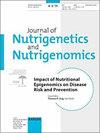墨西哥人群中乳糖酶持久性基因型与高乳制品饱和脂肪摄入量和高乳糖酶不持久性的相关性
Q Agricultural and Biological Sciences
Journal of Nutrigenetics and Nutrigenomics
Pub Date : 2016-01-01
Epub Date: 2016-07-02
DOI:10.1159/000446241
引用次数: 13
摘要
背景/目的:与乳糖酶非持久性(LNP)/持久性(LP)表型相关的乳糖酶(LCT) -13910 C>T和-22018 G>A多态性在全球范围内存在差异。在欧洲,脂肪肝与肥胖有关。然而,在墨西哥还没有进行基因评估,墨西哥是一个人口混合的国家,最近引入了乳制品,肥胖的患病率很高。因此,我们旨在确定LCT多态性的分布及其与西墨西哥人口营养状况的关系。方法:采用Taqman等位基因鉴别法对1196例个体(本地和混血儿)进行基因分型。描述性统计和种群间分析采用SPSS、Arlequin和Structure软件进行。分析了212个混血儿的人口统计学、人体测量学、生化和饮食资料。结果:以LNP基因型为主(CC 68.7%, GG 68.2%);两者均占优势(>97.7%)。在混血儿中,LP基因型与较高的饱和脂肪摄入量相关(9.9±3.9% vs 8.5±4.0%,p = 0.018;OR = 2.55, 95% CI 1.29-5.03, p = 0.006)和每天或更频繁地食用乳制品(88.8比78.0%;p = 0.049)高于LNP基因型。结论:LNP性状在具有主要美洲印第安人血统的墨西哥人中占主导地位。在LP个体中,每日食用乳制品与较高的饱和脂肪摄入量有关。本文章由计算机程序翻译,如有差异,请以英文原文为准。
Association of Lactase Persistence Genotypes with High Intake of Dairy Saturated Fat and High Prevalence of Lactase Non-Persistence among the Mexican Population.
Background/Aim: Lactase (LCT) -13910 C>T and -22018 G>A polymorphisms associated with the lactase non-persistence (LNP)/persistence (LP) phenotypes vary globally. LP has been associated with obesity in Europeans. However, it has not been genetically evaluated in Mexico, a country with admixed population, recent introduction of dairy, and a high prevalence of obesity. Thus, we aimed to determine the distribution of the LCT polymorphisms and their association with the nutritional profile of West Mexico's populations. Methods: Genotyping of 1,196 individuals (natives and mestizos) was carried out by a Taqman allelic discrimination assay. Descriptive statistics and interpopulation analyzes were performed by SPSS, Arlequin, and Structure software. Demographic, anthropometric, biochemical and dietary data were analyzed in 212 mestizos. Results: LNP genotypes mainly prevailed (CC 68.7% and GG 68.2%); both predominated in native Huicholes and Nahuas (>97.7%). Among the mestizos, the LP genotypes were associated with a higher intake of saturated fat (9.9 ± 3.9% vs. 8.5 ± 4.0%, p = 0.018; OR = 2.55, 95% CI 1.29-5.03, p = 0.006) and a daily/more frequent consumption of dairy (88.8 vs. 78.0%; p = 0.049) than LNP genotypes. Conclusion: The LNP trait was predominant in Mexicans with a major Amerindian ancestry. A daily consumption of dairy was associated with a higher intake of saturated fat in LP individuals.
求助全文
通过发布文献求助,成功后即可免费获取论文全文。
去求助
来源期刊

Journal of Nutrigenetics and Nutrigenomics
GENETICS & HEREDITY-NUTRITION & DIETETICS
CiteScore
1.86
自引率
0.00%
发文量
0
审稿时长
>12 weeks
期刊介绍:
The emerging field of nutrigenetics and nutrigenomics is rapidly gaining importance, and this new international journal has been established to meet the needs of the investigators for a high-quality platform for their research. Endorsed by the recently founded "International Society of Nutrigenetics/Nutrigenomics", the ‘Journal of Nutrigenetics and Nutrigenomics’ welcomes contributions not only investigating the role of genetic variation in response to diet and that of nutrients in the regulation of gene expression, but is also open for articles covering all aspects of gene-environment interactions in the determination of health and disease.
 求助内容:
求助内容: 应助结果提醒方式:
应助结果提醒方式:


